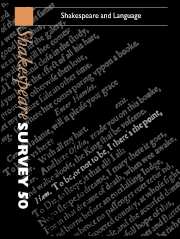Book contents
- Frontmatter
- Shakespeare’s Language and the Language of Shakespeare’s Time
- ‘I’ll plague thee for that word’: Language, Performance, and Communicable Disease
- The Language of the Spectator
- Marlowe’s Edward II: Penetrating Language in Shakespeare’s Richard II
- Hamlet’s Ear
- Secrecy and Gossip in Twelfth Night
- Shakespeare Rewriting Ovid: Olivia’s Interview with Viola and the Narcissus Myth
- ‘Voice Potential’: Language and Symbolic Capital in Othello
- Household Words: Macbeth and the Failure of Spectacle
- Erring and Straying Like Lost Sheep: The Winter’s Tale and The Comedy of Errors
- The ‘Shakespearian Gap’ in French
- Reading the Early Modern Text
- Shakespeare and the Metamorphosis of the Pentameter
- Rereading Illustrations of the English Stage
- Nietzsche’s Hamlet
- ‘Strange and woonderfull syghts’: The Tempest and the Discourses of Monstrosity
- Shakespeare Performances in England, 1996
- Professional Shakespeare Productions in the British Isles, January–December 1995
- 1 Critical Studies
- 2 Shakespeare’s Life, Times, and Stage
- 3 Editions and Textual Studies
- Books Received
- Index
Hamlet’s Ear
Published online by Cambridge University Press: 28 March 2007
- Frontmatter
- Shakespeare’s Language and the Language of Shakespeare’s Time
- ‘I’ll plague thee for that word’: Language, Performance, and Communicable Disease
- The Language of the Spectator
- Marlowe’s Edward II: Penetrating Language in Shakespeare’s Richard II
- Hamlet’s Ear
- Secrecy and Gossip in Twelfth Night
- Shakespeare Rewriting Ovid: Olivia’s Interview with Viola and the Narcissus Myth
- ‘Voice Potential’: Language and Symbolic Capital in Othello
- Household Words: Macbeth and the Failure of Spectacle
- Erring and Straying Like Lost Sheep: The Winter’s Tale and The Comedy of Errors
- The ‘Shakespearian Gap’ in French
- Reading the Early Modern Text
- Shakespeare and the Metamorphosis of the Pentameter
- Rereading Illustrations of the English Stage
- Nietzsche’s Hamlet
- ‘Strange and woonderfull syghts’: The Tempest and the Discourses of Monstrosity
- Shakespeare Performances in England, 1996
- Professional Shakespeare Productions in the British Isles, January–December 1995
- 1 Critical Studies
- 2 Shakespeare’s Life, Times, and Stage
- 3 Editions and Textual Studies
- Books Received
- Index
Summary
An alienation from the hypocrisy of a courtly style or decorum in language afflicts Hamlet from his first appearance in the play. The courtly airs or ‘songs’, the ‘words of so sweet breath’, the ‘music vows’, with which he wooed Ophelia are no longer part of his idiom, although he will briefly redeploy them to disguise his true state of mind. In Act I scene 2, we meet a Hamlet whose abrupt retreat from social intercourse is not only signalled by his mourning dress, but is also articulated through an intensely satiric relationship to language. This scathing view of the world is articulated in all of Hamlet’s language, in his soliloquies and monologues as well as in his dialogues with others; it finds its most effective form of expression, however, in his use of wordplay. Indeed, before the final tragic catastrophe Hamlet’s role as malcontent and revenger succeeds not so much by action as by his disordering, through punning, of social constructions of identity. The centrality of the pun to the view of earthly mutability and death which Hamlet gradually elaborates in the course of the play is aptly illustrated by the fact that he puns not only on his own death (‘The rest is silence’), but also as he finally accomplishes his task of revenge and kills Claudius, asking ‘Is thy union here?’ as he forces him to drink the wine that Claudius has poisoned with a pearl or ‘union’. Yet the chief interest of Hamlet's quibbling lies not in his semantic puns, which play upon words with two or more meanings, like 'rest' or 'union', but in his richly suggestive use of homophonic resemblances between words, in order to expand their significance.
- Type
- Chapter
- Information
- Shakespeare Survey , pp. 57 - 64Publisher: Cambridge University PressPrint publication year: 1997
- 1
- Cited by

